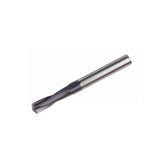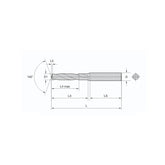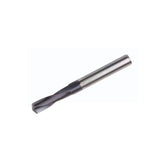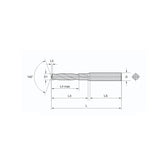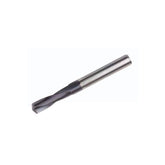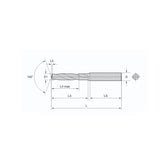Teach You How to Choose Carbide Drill Bits Correctly
How to Correctly Select a Carbide Drill Bit
Maximize productivity and minimize cost per hole with the right carbide drill selection
It was once believed that drilling required low feed rates and cutting speeds, a view that held true for ordinary drill bits. With the advent of cemented carbide drill bits, drilling has evolved. By selecting the appropriate cemented carbide drill bit, you can significantly boost productivity and reduce the cost per hole.
Basic Types of Cemented Carbide Drill Bits
1. Overall Cemented Carbide Drill Bit
Application: Advanced machining centersCharacteristics:
- Made of fine-grained cemented carbide material
- Coated to extend service life
- Specially designed geometry provides self-centering function
- Good chip control and removal performance for most workpiece materials
2. Cemented Carbide Indexable Blade Drill Bit
Application: Lathes and rotary machining machinesCharacteristics:
- Wide range of processing hole diameters
- Processing depth range of 2D to 5D (D is the hole diameter)
3. Welded Cemented Carbide Drill Bit
Application: Machining centers, CNC lathesCharacteristics:
- Made by firmly welding a cemented carbide crown on a steel drill body
- Uses self-centering geometry with low cutting force
- Achieves good chip control for most workpiece materials
- Produces holes with good surface finish
- High dimensional and positioning accuracy, eliminating the need for subsequent finishing
- Uses internal cooling
4. Replaceable Cemented Carbide Crown Drill Bit
Application: High-rigidity, high-speed machinesCharacteristics:
- Made by firmly welding a cemented carbide crown on a steel drill body
- Uses self-centering geometry with low cutting force
- Achieves good chip control for most workpiece materials
- Produces holes with good surface finish
- High dimensional and positioning accuracy, eliminating the need for subsequent finishing
- Uses internal cooling
Factors to Consider When Selecting
1. Machining Accuracy
When selecting a cemented carbide drill bit, first consider the dimensional accuracy requirements for drilling. Generally, smaller hole diameters require tighter tolerances. Drill bit manufacturers classify bits based on the nominal diameter of the hole to be machined.
Among the four types, overall cemented carbide drill bits offer the highest machining accuracy (tolerance range of 0–0.03mm for a φ10mm bit), making them the best choice for high-precision holes. Indexable blade drill bits are suited for heavy-duty roughing, with lower machining costs but also lower accuracy (tolerance range of 0–0.3mm, depending on the length-to-diameter ratio).
2. Machining Stability
Beyond precision, consider the stability of the machining tool. Machine stability is critical for the drill bit's service life and hole accuracy, so inspect the spindle, fixtures, and accessories. The drill bit's own stability is also important.
Welded and replaceable crown drill bits feature two symmetrical cutting edges with a self-centering geometric shape, offering high stability. They typically don't require reduced feed rates when entering the workpiece, except when installed at an angle, where a 30%–50% feed rate reduction is advised during entry and exit.
3. Chip Removal and Coolant
Chip removal is a critical issue in drilling, particularly with low-carbon steel, where poor chip removal is common and unavoidable. Workshops often use external coolant injection to aid chip removal, but this is effective only for shallow holes (depth less than diameter) and reduced cutting parameters.
Select a coolant type, flow rate, and pressure matching the drill bit diameter. For machines without internal spindle cooling, use a coolant hose. Deeper holes require higher coolant pressure, so ensure the manufacturer's recommended minimum coolant flow. If flow is insufficient, reduce the feed rate.
4. Cost Per Hole
Productivity and cost per hole are key factors in drilling. Manufacturers are developing tools that integrate multiple operations and support high feed and speed. Overall cemented carbide drill bits can be reground 7–10 times, welded bits 3–4 times, while replaceable crown bits allow 20–30 crown replacements for steel, with no regrinding needed, enabling maximum feed and speed.
Replaceable crown bits offer excellent economy. Crowns are easy to replace with high repeatability, allowing one drill body to process various hole sizes. This modular system reduces manufacturing and management costs for 12–20mm diameter bits and eliminates backup tool costs for regrinding. Consider the total lifespan when calculating cost per hole.
Drill Bit Comparison
Below is a comparison of the different cemented carbide drill bit types based on key selection factors:
| Type | Application | Precision | Stability | Cost Efficiency | Coolant |
|---|---|---|---|---|---|
| Overall | Advanced machining centers | High (0–0.03mm) | Moderate | Moderate (7–10 regrinds) | External/Internal |
| Indexable Blade | Lathes, rotary machines | Low (0–0.3mm) | Moderate | High (low initial cost) | External |
| Welded | High-rigidity machines | High | High (self-centering) | Low (3–4 regrinds) | Internal |
| Replaceable Crown | High-speed machines | High | High (self-centering) | Very High (20–30 replacements) | Internal |
Get premium carbide drill bits with expert technical support
